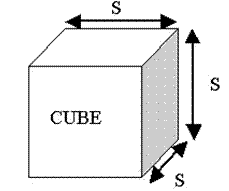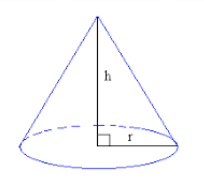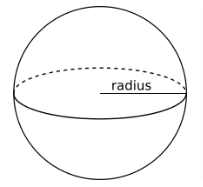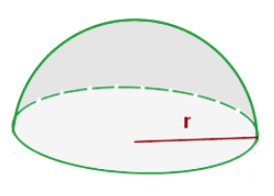Formulas
| Cuboid |
Volume V = length × breadth × height Surfacearea = 2 (lw + wh + hl) |
| Cube |
Volume V = $S^3$ Surfacearea = $6a^2 $ Diagonal = $\sqrt{3}$a |
| Cone |
Volume V = $\dfrac{1}{3}Bh$ or $V=\dfrac{1}{3}\pi r^{2}h$ Curved surface area = $πrl$ Total Surface area = $πrl + πr^2$ or $πr (l+r)$ |
| Cylinder |
Volume V = $πr^{2}h$ Curved surface area = 2πrh Total Surface area = $2πrh+2πr^2$ or 2πr(r + h) |
| Sphere |
Volume V = $\dfrac{4}{3} \pi r^{3}$ Surface area = $4π r^2$ |
| Hemi Sphere |
Volume V = $\dfrac{2}{3} \pi r^{3} $ Surface area = $2 π r^2$ Total Surface area = $3 π r^2$ |
Volume
Volume is the amount of space inside a three-dimensional (length, width and height.) object, or its capacity. measured in cubic units.
Surface Area
Total area of the surface of a 3D object, measured in square units.
Difference between Volume & Surfce Area with example
Surface area is the area of the thin sheet of aluminum required to make a soda can.
Volume is the amount of soda in the can.
CUBOID
A cuboid is a three-dimensional shape with a length, width, and a height.

Volume of a Cuboid
Formula
Example
Find the volume of a cuboid of length 20 cm, breadth 15 cm and height 10 cm.
here,
length - 20 cm
breadth - 15 cm
height - 10 cm
Now calculating Volume of Cuboid
Volume of cuboid = length × breadth × height
Now applying this values to formula
Volume = 20cm x 15 cm x 10 cm.
= 3000 $cm^3$
Exercise
Volume of a Cuboid= length × breadth × height
= $4 \times 6 \times 10$
= 240 $cm^3$
Surface area of a Cuboid
Formula
Diagonal = $\sqrt{l^{2}+ w^{2} + h^{2}}$
The Surface area of a cuboid is the sum of the areas of its 6 faces.
(i.e) Surface Area of a Cuboid = 2lw + 2wh +2 hl = 2 (lw + wh + hl)
Example
Find the total surface area and diagonal length of a cuboid with dimensions 8 cm by 6 cm by 5 cm
here,
l = 8 cm
w = 6 cm
h = 5 cm
First calculating Surface Area
Surfacearea of a Cuboid = 2 (lw + wh + hl)
= 2 [$(8 \times 6) + (6 \times 5) + (5 \times 8)$]
= 2 (48 + 30 + 40)
= 2(118)
= 236 $cm^2$
Next Calculating diagonal length
Diagonal = $\sqrt{l^{2}+ w^{2} + h^{2}}$
= $\sqrt{8^{2}+ 6^{2} + 5^{2}}$
= $\sqrt{64 + 36 + 25}$
= $\sqrt{125}$
= $\sqrt{125}$
= $\sqrt{5^3}$
= $\sqrt{5^2 \times 5^1}$
= 5 $\sqrt{5}cm$
Exercise
Surface area of a cuboid = 2(lb+bh+hl) cm square
Surface area of a brick = 2(10*4+4*3+3*10) cm square
= 2(82) cm square = 164 cm square
CUBE
A cube has Six sides (faces). Each face is a square of side length 'a'. which are all the same size.
Volume of a Cube
Formula
So, the formalu of volume is = length × breadth × height
= S x S x S
Volume = $S^3$
Example
The length of a cubic shape box is 15 cm. What is the volume of the box?
here,
The length of cubic box = 15 cm
Now calculating Volume of Cube
Volume of Cube = $S^3$
= 15 x 15 x 15
= 3375 $cm^3$
Exercise
Volume of a Cube = $a^3$
=$ 8 \times 8 \times 8$
= 512 $cm^3$
Surface Area of a Cube
Formula
DiagonalofaCube = $\sqrt{3}$a
The area of a square is $ a^2 $.
The total surface area is the sum of the area of each surface.
∴ Surface Area = $ a^2 + a^2 + a^2 + a^2 + a^2 + a^2 = 6a^2 $
The total surface area is the sum of the area of each surface.
The main diagonal of any cube is multiplying the length of one side by the square root of 3.
Example
Find the total surface area and diagonal of a box whose edges are all 5.5 cm long.
here,
Edge (face) = 4.5 cm
First , calculating Surface area
Now calculating Surface area of Cube
Surface area of Cube = $6a^2 $
= $6(5.5)^2 $
= 6 $\times$ 30.25
= 181.5 $cm^2$
Now calculating the diagonal of the cube
DiagonalofaCube = $\sqrt{3}$a
= $\sqrt{3}\times 5.5$
= 1.732 $\times 5.5$
= 9.526 cm
Exercise
Surfacearea of a Cube = $6a^2$
= $6 \times (8.7)^2$
=454.14 $cm^2$
CONE
A solid (3-dimensional) object with a circular flat base joined to a curved side that ends in an apex point.
Volume of a Cone
Formula
Where B= $\pi r^2$
The volume V of a cone with radius r is one-third the area of the base B times the height h
where π is a number that is approximately equals to 3.14 or $\dfrac{22}{7}$
Example
Calculate the volume of a cone if the height is 12 cm and the radius is 7 cm.
here,
Height of the cone = 12 cm
Radius of the cone = 7 cm.
V = $\dfrac{1}{3} \pi r^{2}h$
V = $\dfrac{1}{3} \times \dfrac{22}{7} \times 7^{2} \times 12$
V = 616$ cm^{3}$
Exercise
respectively. Find the volume of the cone.
$l^2 = r^2 + h^2$
r = $\sqrt{l^{2}- h^{2}} = \sqrt{28^{2}- 21^{2}}$
=7$\sqrt{7}$
volume of the cone = $\frac{1}{3} \pi r^2 h = \dfrac{1}{3} \times 3.142 \times 7 \sqrt{7} \times 7 \sqrt{7} \times 21$
=7546 $cm^3$
Surface Area of the Cone
Formula
Total Surface area of a Cone = $πrl + πr^2$ or $πr (l+r)$
slant height l = $\sqrt{h^{2}+r^{2}}$
The Curved surface area of a Cone is the surface area of the outside of the cone
The Total surface area of a cone = The surface area of the outside of the cone + The surface area of the circle
r - is the radius, h - is the height , l - is the slant height
Example
The diameter of a cone is 16 cm and its height is 6 cm. Find the Curved surface area and Total surface area of cone.
here,
d = 16 => r = d/2 = 16/2 = 8cm
r= 8 cm
h = 6 cm
l = $\sqrt{h^{2}+r^{2}}$ = $\sqrt{6^{2} + 8^{2}}$ = $\sqrt{36+64}$ = $\sqrt{100}$ = 10 cm
l = 10 cm
First calculating Curved surface area of the cone
Curved surface area of the cone = $πrl$
= $\dfrac{22}{7} \times 8 \times 10$
= 3.142 $\times 8 \times 10$
= 251.36 $cm^2$
Now calculating Total Surface area of a cone
Total Surface area of a
Cone = $πrl + πr^2$
= 251.36 + $\dfrac{22}{7} \times 8^2$
= 251.36 + (3.142 $\times $ 64)
= 251.36 + 201.08
= 452.44 $cm^2$
Exercise
Total Surface area of a Cone = $πr (l+r)$
= $3.142 \times 6 (10+6)$
= 301.59 $inches^2$
CYLINDER
A cylinder is a closed solid that has two parallel (usually circular) bases connected by a curved surface.
Volume of a Cylinder
Formula
where, r: Radius of a cylinder , h: Height of a cylinder and π is equal to 22/7 or 3.14
Example
Find the Volume of a cylinder whose height is 28 cm and radius 6 cm
here,
Height of the cylinder = 28 cm
Radius of the cylinder = 6 cm
Now calculating Volume of cylinder
volume of a cylinder = $πr^{2}h$
= $ \dfrac{22}{7} \times 6^{2} \times 28$
= 3165.12 $cm^3$
Exercise
volume of a cylinder = $πr^2h$
= $3.142 \times 6 \times6 \times 12$
= 1357.2 $cm^3$
Surface Area of a Cylinder
Formula
Total surface area of a cylinder = $2πrh+2πr^2$ or 2πr(r + h)
The curved surface area is defined as the area of only curved surface, leaving the circular top and base
The Total surface area of the curved surface as well as the bases.
The Total surface area = curved surface area + (2 × area of circle)
The area of a circle is $πr^2$, so the combined area of the two disks is twice that, or $2πr^2$.
Example
The diameter of the base of a cylinder is 10 cm and the height is 8 cm. Find the surface area of the solid cylinder
here,
Diameter (base) = 10 cm
Radius = Diameter /2 = 10/2 = 5 cm
r = 5m
First calculate the curved surface area
curved surface area of a cylinder = 2πrh
= $2 \times \dfrac{22}{7} \times 5 \times 8$
=251.36 $cm^2$
now find the total surface area of a cylinder
Total surface area of a cylinder = $2πrh+2πr^2 $
= 251.36 + 2 $\times 3.142 \times 5^2$
= 408.41 $cm^2$
Exercise
Total surface area of a cylinder = $2 \pi r(r+h)$
= $2 \times 3.142 \times 15 \times (15+17)$
= 3016.32 $cm^2$
SPHERE
A 3-dimensional object shaped like a ball. Every point on the surface is the same distance from the centre.

Volume of a Sphere
Formula
Where, r: Radius of a Sphere
The volume V of a sphere is four-thirds times pi times the radius cubed.
Example
Calculate the volume of sphere with radius 4 cm.
here,
Radius of the sphere = 4 cm
Now calculating Volume of sphere
volume of a sphere V = $\dfrac{4}{3} \pi r^{3}$
= $\dfrac{4}{3} \times \dfrac{22}{7} \times 4 \times 4 \times 4$
= 268.19 $cm^3$
Exercise
Required volume =$\dfrac{4}{3}πr^3$
= $\dfrac{4}{3} \times \dfrac{22}{7} \times 11.2 \times 11.2 \times 11.2$
= 5887.32 $cm^3$
Surface Area of a Sphere
Formula
Where r is the radius of the sphere.
The surface area of a sphere is exactly four times the area of a circle with the same radius.
The area of a circle = $πr^2 $, and the surface area of a sphere = $4πr^2$
Example
Find the surface area of a sphere of radius 25cm.
here,
r = 25 cm
Surface area of a sphere = $4π r^2$
π = 3.142
= $4 \times 3.142 \times 25 \times 25$
= 7855 $cm^2$
Exercise
The surface area of a sphere of radius 7 cm would be
$4πr^2$ = 4 ×22/7× 7 × 7 $cm^2$ = 616 $cm^2$
HEMISPHERE
A hemisphere is half a sphere, with one flat circular face and one bowl-shaped face.

Volume of a Hemisphere
Formula
The volume of a hemisphere is equal to two thrids of the cube of the radius by pi.
Where, r: Radius of a Sphere
Example
Find the volume of the hemisphere, whose radius is 10 cm.
here,
Radius of the sphere = 10 cm
Now calculating Volume of sphere
volume of a hemisphere V = $\dfrac{2}{3} \pi r^{3}$
=$\dfrac{2}{3} \times \dfrac{22}{7} \times 10^{3}$
= 23 x 3.14 x 1000
= 23 x 3140
= 2093.3 $cm^3$
Exercise
volume of water it would contain?
The volume of water the bowl can contain
= $\dfrac{2}{3} \pi r^3$
= $\dfrac{2}{3} \times \dfrac{22}{7} \times 3.5 \times 3.5 \times 3.5$
= 89.8 $ cm^3$
Surface Area of Hemisphere
Formula
Total surface area of Hemisphere = $3 π r^2$
The hemisphere is to include the base then the surface area is 2 π $r^2$ + π $r^2$ = 3 π $r^2$
Example
Find the curved surface area and total surface area of a hemisphere having the radius of 7 cm?
here,
r = 7 cm
First calculate the curved surface area
Curved surface area of Hemisphere = $2 π r^2$
= 2 $\times 3.142 \times 7 \times 7
= 308 cm^2$
Now calculate the total surface area
Total surface area of Hemisphere = $3 π r^2$
= 3 $\times 3.142 \times 7 \times 7$
= 462 $cm^2$
Exercise
The curved surface area of a hemisphere of radius 21 cm would be
= $2πr^2 = 2 ×22/7× 21 × 21 cm^2 = 2772 cm^2$
